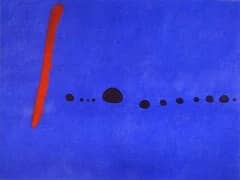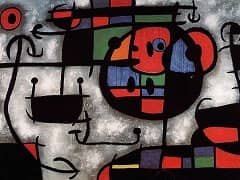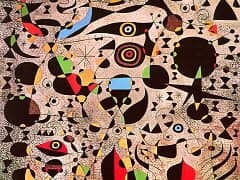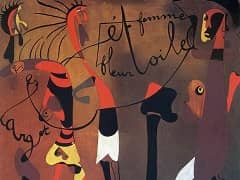Painting Poem, 1925 by Joan Miro

During the twenties, which were so important for Miro, he also produced his so-called picture poems, picture s in which he combines colors and words. In this one , two smears of white paint cover a spotty, brown surface, connected by two red arches with black dots. There are two breast-shaped blue eyes in the right half of the picture, with reddish-yellow "tongues" that protrude from their sides and are linked to each other by a line of white paint. Another white line trickles down from above, forming a cross with the first line. The entire picture is covered with the hand-written words of a popular folk song: Le corps de ma brune .....
The different elements of the painting form three levels of space which are related to one another in a way that fluctuates: because of its vague color structure, the brown surface seems to be the most spacious of all, followed by the icon-like, semi-transparent way in which the paint has been applied, and finally the firm, black words which seem to be asserting themselves quite confidently. This economy of means makes for a stunning effect of spaciousness and an interesting overall structure. However, there is also the poetic dimension of the picture, because word and color are mutually suggestive, just as colors and vowels are related to femininity in Rimbaud's famous poem Voyelles. And so The Body of My Brunette can be seen both literally and symbolically, e.g. in the shapes of the breasts and the veil of color which can be understood as hair.
Not only do Miro's picture poems form part of one of the most interesting traditions in modern symbolic language, but they are also among his most multi-faceted and most beautiful paintings.
















